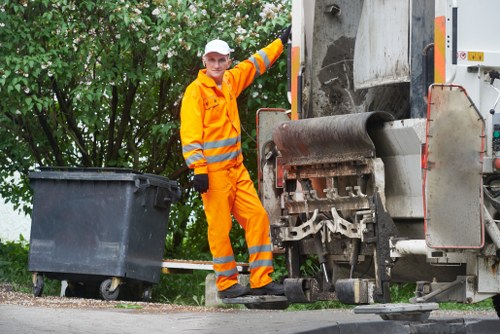Recycling and Rubbish in Commercial Waste Disposal

Introduction to Commercial Waste Disposal
In today’s **environmentally conscious** world, commercial waste disposal plays a pivotal role in maintaining sustainability. Businesses, regardless of their size, generate a significant amount of waste that needs to be managed effectively. Proper disposal and recycling not only help in reducing the environmental footprint but also contribute to the overall efficiency and reputation of the organization.
Understanding the intricacies of recycling and rubbish management in the commercial sector is essential for companies aiming to comply with regulations and promote eco-friendly practices. This article delves into the various aspects of commercial waste disposal, highlighting the importance of recycling and sustainable rubbish management.
Effective waste management strategies can lead to substantial cost savings, improved resource utilization, and enhanced corporate image. By adopting comprehensive recycling programs, businesses can significantly reduce the amount of waste sent to landfills and promote a circular economy.

The Importance of Recycling in Commercial Waste
Recycling is a cornerstone of sustainable waste management. In the commercial realm, recycling helps in diverting waste from landfills, conserving natural resources, and reducing greenhouse gas emissions. Businesses that prioritize recycling demonstrate their commitment to environmental stewardship, which can resonate positively with customers and stakeholders.
Key Benefits of Recycling in Commercial Waste Disposal:
- **Cost Reduction**: Lower disposal fees and potential revenue from recycled materials.
- **Resource Conservation**: Preserves raw materials and reduces the need for resource extraction.
- **Regulatory Compliance**: Meets local and national recycling mandates and environmental regulations.
- **Corporate Reputation**: Enhances brand image and attracts eco-conscious consumers.
Implementing effective recycling programs can transform how businesses handle their waste, leading to more sustainable operations and long-term benefits.

Types of Commercial Waste
1. Organic Waste
Organic waste includes food scraps, landscaping debris, and other biodegradable materials. Proper disposal and recycling of organic waste can lead to composting, which enriches soil and supports agricultural activities.
2. Recyclable Materials
Common recyclable materials in commercial settings include paper, cardboard, plastics, glass, and metals. Establishing separate collection points for these materials simplifies the recycling process and increases efficiency.
3. Hazardous Waste
Hazardous waste consists of chemicals, batteries, electronic waste, and other materials that require special handling and disposal methods. Ensuring safe disposal of hazardous waste is crucial to prevent environmental contamination and comply with safety regulations.

Strategies for Effective Commercial Waste Disposal
1. Waste Audits
Conducting regular waste audits helps businesses understand the composition and volume of their waste. This information is vital for developing targeted recycling programs and identifying areas for waste reduction.
2. Employee Training
Educating employees about proper waste segregation and recycling practices ensures that waste management processes are followed correctly. Training sessions and informational materials can foster a culture of sustainability within the organization.
3. Partnering with Waste Management Services
Collaborating with professional waste management companies provides businesses with the expertise and resources needed for efficient waste disposal and recycling. These partners can offer tailored solutions that align with the company’s specific needs and sustainability goals.

Innovations in Commercial Recycling
1. Advanced Sorting Technologies
Modern recycling facilities utilize advanced sorting technologies, such as AI-powered sensors and automated conveyor systems, to enhance the accuracy and efficiency of material separation. These technologies reduce contamination and improve the quality of recycled materials.
2. Circular Economy Initiatives
The circular economy model emphasizes the reuse and regeneration of materials, minimizing waste generation. Businesses adopting circular practices can create closed-loop systems where products are designed for longevity, reuse, and recyclability.
3. On-Site Recycling Solutions
On-site recycling equipment allows businesses to process certain types of waste internally, reducing the dependency on external waste management services. This approach can lead to quicker waste handling and lower transportation costs.
Challenges in Commercial Waste Recycling
Despite the numerous benefits, commercial recycling faces several challenges that businesses must navigate:
- **Contamination**: Improper sorting and contamination of recyclable materials can hinder the recycling process and reduce the quality of outputs.
- **Cost Constraints**: Initial setup costs for recycling programs and ongoing operational expenses can be significant, particularly for small and medium-sized enterprises.
- **Lack of Awareness**: Insufficient knowledge about recycling practices and benefits can impede the adoption of effective waste management strategies.
- **Regulatory Hurdles**: Navigating complex regulations and compliance requirements can be daunting for businesses, especially those operating in multiple jurisdictions.
Addressing these challenges requires a proactive approach, including continuous education, investment in technology, and collaboration with industry experts.
Best Practices for Commercial Waste Disposal
1. Implement a Comprehensive Recycling Policy
Developing a clear and comprehensive recycling policy sets the foundation for effective waste management. The policy should outline the types of waste to be recycled, procedures for waste segregation, and roles and responsibilities of employees.
2. Invest in Quality Recycling Bins and Signage
Providing clearly labeled recycling bins and strategic signage helps in proper waste segregation. Ensuring that recycling stations are conveniently located encourages employees to participate actively in recycling efforts.
3. Monitor and Report Recycling Metrics
Regularly tracking recycling metrics, such as the volume of materials recycled and cost savings achieved, allows businesses to measure the effectiveness of their waste management strategies. Reporting these metrics can also demonstrate commitment to sustainability to stakeholders.
Future Trends in Commercial Waste Management
The landscape of commercial waste disposal is continually evolving, with innovations and trends shaping the future of recycling:
- **Smart Waste Management Systems**: Integration of IoT and data analytics to optimize waste collection and recycling processes.
- **Zero Waste Initiatives**: Striving for zero waste by redesigning processes and products to eliminate waste generation entirely.
- **Sustainable Packaging**: Adoption of eco-friendly packaging materials to reduce waste and enhance recyclability.
- **Extended Producer Responsibility (EPR)**: Companies taking responsibility for the entire lifecycle of their products, including end-of-life disposal and recycling.
Staying abreast of these trends enables businesses to adopt forward-thinking waste management practices that align with global sustainability goals.
Conclusion
**Recycling and rubbish management** are integral components of effective commercial waste disposal. By implementing robust recycling programs, businesses can achieve sustainability, reduce costs, and enhance their corporate image. Overcoming challenges through education, investment, and collaboration is essential for the successful management of commercial waste.
Embracing innovative solutions and future trends will further bolster a company’s waste management efforts, ensuring long-term environmental and economic benefits. **Contact us today** to learn how we can help your business implement effective recycling and rubbish disposal strategies.